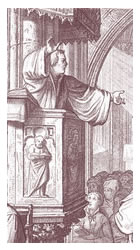by Dr. John W. Oberdeck
 Luther planned the Ninety-Five Theses for academic debate. The popular document moved rapidly beyond Luther’s intention and became the rallying point of the Reformation. Soon Luther and the other reformers found themselves making public confession of what they believed and taught.
Luther planned the Ninety-Five Theses for academic debate. The popular document moved rapidly beyond Luther’s intention and became the rallying point of the Reformation. Soon Luther and the other reformers found themselves making public confession of what they believed and taught.
Public confession of faith helps distinguish Scripture’s teachings from human error and at the same time provides a way of teaching the faith. Through a lengthy historical process, the Roman Catholic Sacrament of Confirmation was adapted into the Rite of Confirmation. The Reformation Church found the rite useful for two reasons: (1) It provided a means of instruction, and (2) it offered a setting for public confession of the faith.
The Rite of Confirmation in Lutheran Worship and Lutheran Service Book begins with two quotations from Scripture. Why is Matt. 28:18b–20 read as part of the rite?
________________________________
________________________________
What is emphasized in Matt. 10:32–33?
________________________________
________________________________
The word translated as “confess” in the King James and other versions of the Bible comes from a Greek word which means “to say the same thing.” When we say the same thing together, we make a common confession of our faith.
The opposite of a confession is denial. What does Luke 12:8–9 tell us about denying Jesus?
________________________________
________________________________
In another setting, Luke and Mark record something a little different. Look at Luke 9:26 or Mark 8:38. What is the opposite of “confess” in these verses?
________________________________
________________________________
What is the difference between “being ashamed of” and “denying”? How might each affect one’s behavior?
________________________________
________________________________
Before we can confess the faith, we learn the faith. Catechumens learn about the faith they received in Baptism. They learn to “say the same thing” along with the rest of the congregation. They begin a lifelong exploration of God’s Word and what it means to live as God’s child. Catechumens confess the Apostles’ Creed in the Rite of Confirmation and pledge themselves to a life of faithful participation in worship and the Lord’s Supper. Of what significance is confessing the faith according to Paul in Rom. 10:9?
________________________________
________________________________
The early church paid close attention to the beliefs of each member of the Christian community so that members would not fall prey to false teaching, especially about the work and person of Jesus Christ. Peter’s confession (Matt. 16:16) is clear in identifying who Jesus truly is. What false confession was John concerned about in 1 John 4:2–3, and why was it so serious?
________________________________
________________________________
In a season of the church year when the faithful confession of the Reformers is remembered, we are reminded of our responsibility to confess the faith and to instruct the young and the uninformed so that they are equipped to faithfully “say the same thing” with the body of believers. The culture that surrounds us no longer provides support for a God-pleasing style of life. Today, as it did for the Reformers, public confession of the faith can involve risk. Nevertheless we neither deny nor are ashamed of what we have been given, but we seek to follow Paul’s example. What does Paul say about his faith in Rom. 1:16?
_________________________________
_________________________________
In view of our privilege and responsibility to instruct and to confess, why not follow the example of several of our congregations and observe the Rite of Confirmation at Reformation rather than in spring?


